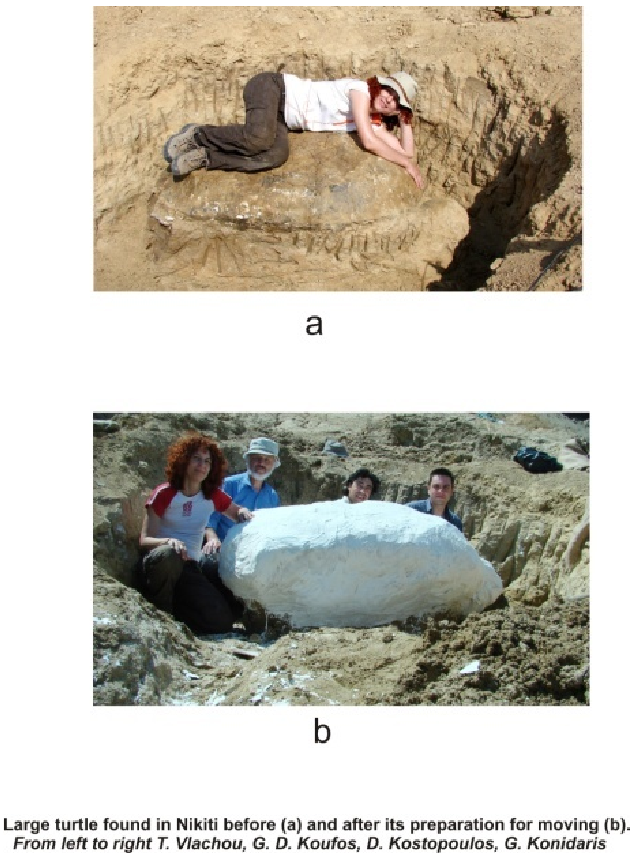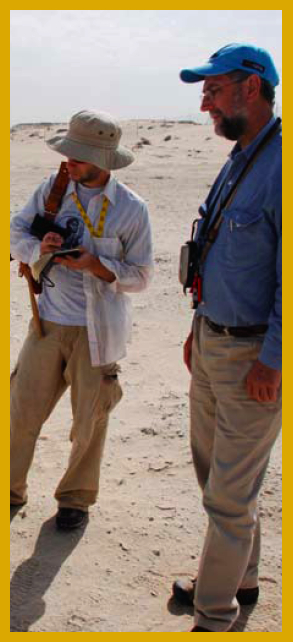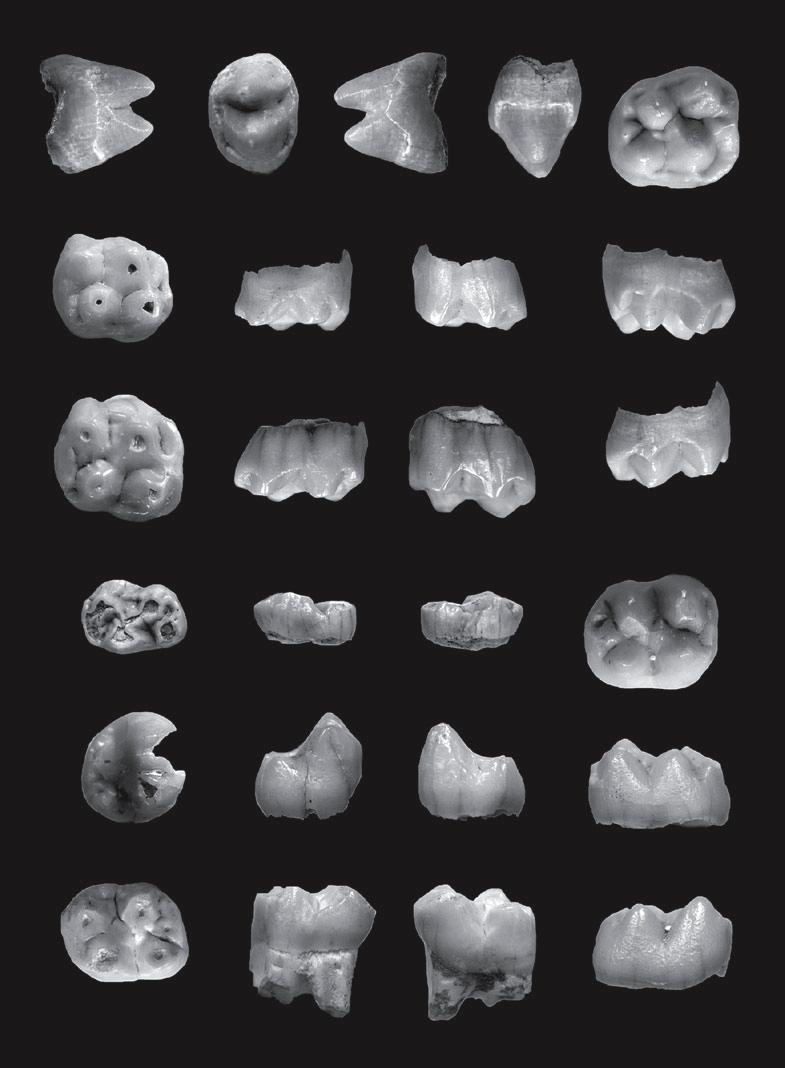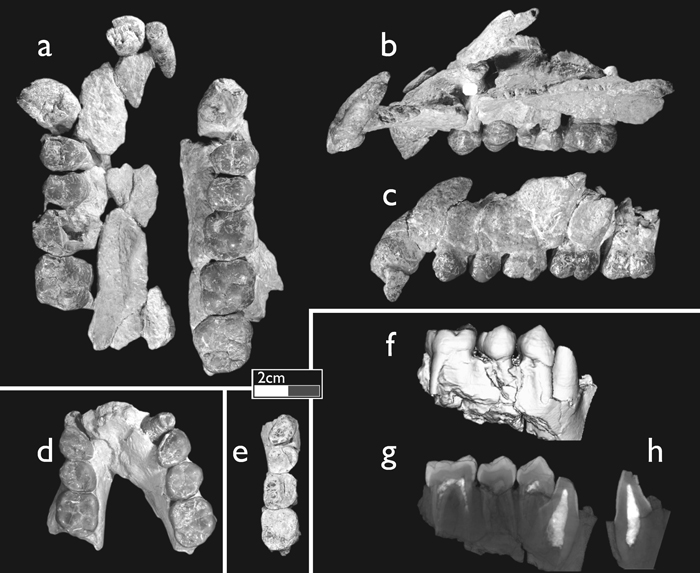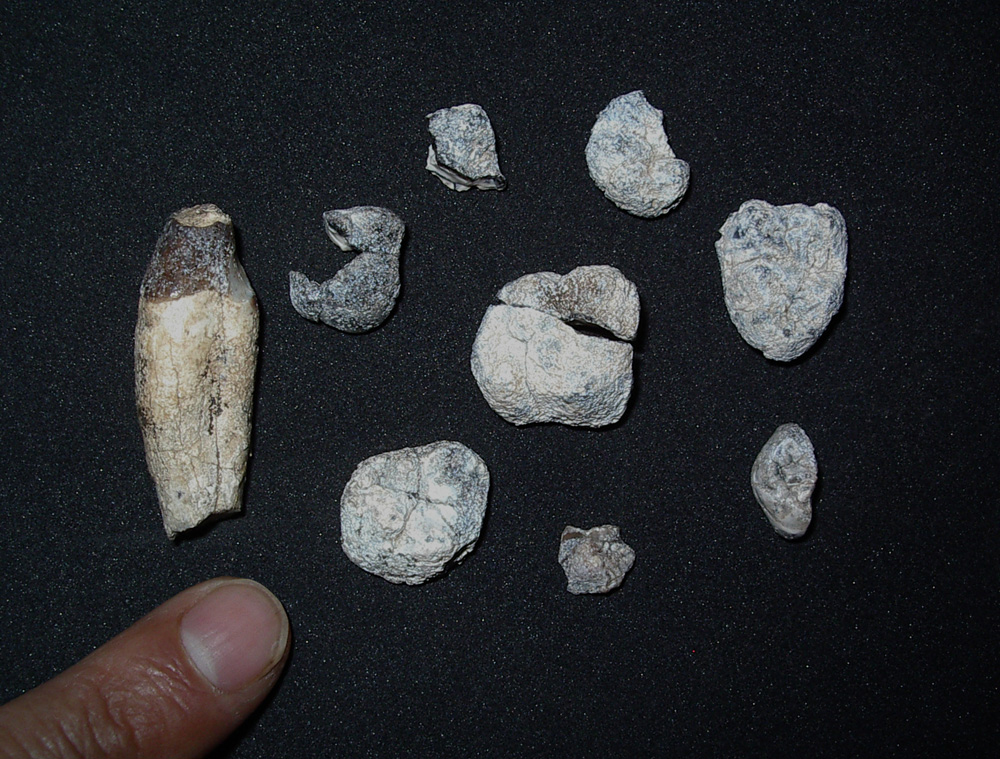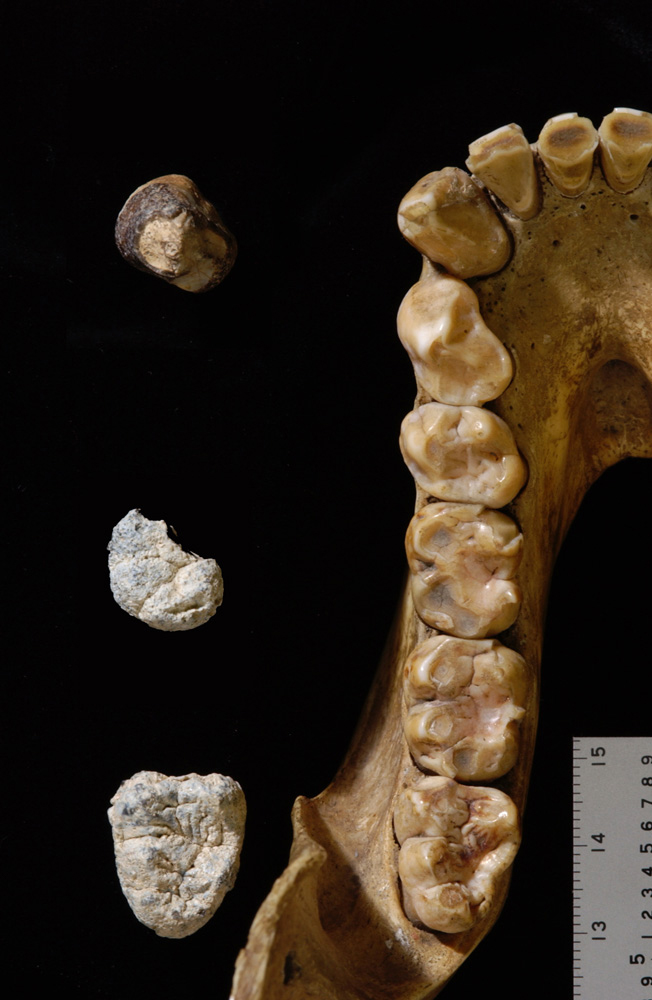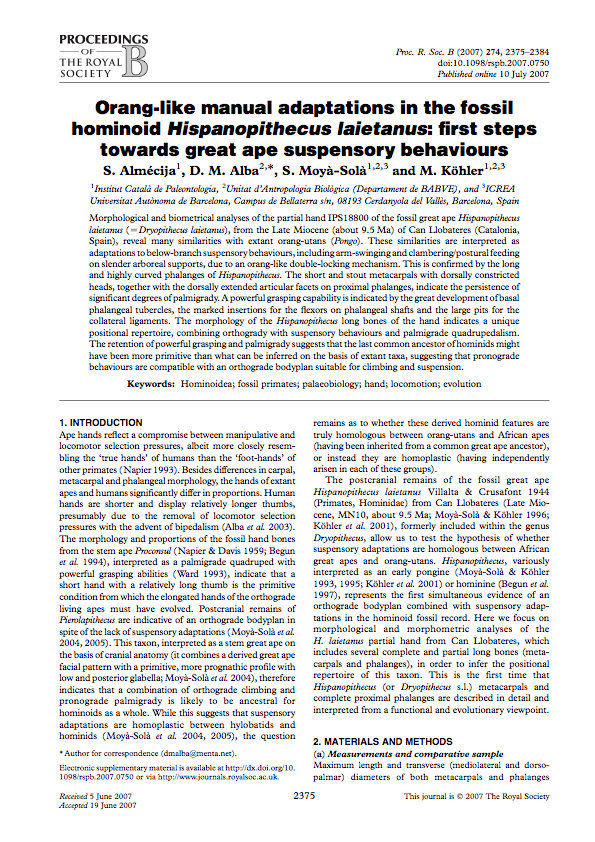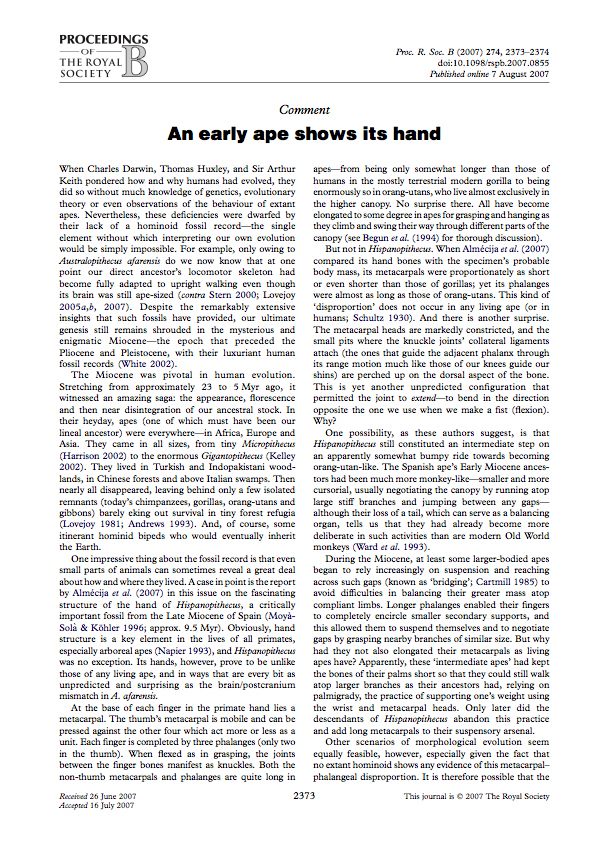HOME • EDUCATION • RHOI PUBLICATIONS • RHOI BIBLIOGRAPHY • RHOI STRUCTURE • INFORMATICS • MAP ARCHIVE: CONTEXTUAL PROJECTS
|
|
2008 NIKITI, GREECE (RHOI-supported) Per Prof. G. D. Koufos: The excavations in the localities of Nikiti (Macedonia, Greece) were continued this summer (June) by a team of palaeontologists of the University of Thessaloniki, lead by Prof. G. D. Koufos. A large terrestrial turtle (length=1.60m; breadth=1.20m) has been unearthed from a new late Miocene fossiliferous site. It was discovered as the bulldozer was working to open the area. Several other fossils (bovids, equids, giraffids, mastodonts) have been discovered in the known fossiliferous site of Nikiti-2.
Excavations at Nikiti (Image: G. Koufos)
YALE UNIVERSITY, CONNECTICUT (Contextual) (RHOI-Supported) The February, 2008 issue of the Yale University Graduate School newsletter features a profile of the Baynunah Research Project and the project's leaders, RHOI members Prof. Andrew Hill and Yale graduate student Faysal Bibi. Working in the emirate of Abu Dhabi, a multinational team including scholars from Yale and the Abu Dhabi Authority for Culture and Heritage (ADACH) are researching the ecology of the Arabian Penninsula during the late Miocene. Preliminary fossil finds from Baynunah are described along with details of survey and collection methods. The article also features the work of Prof. Hill in helping to develop paleontological infrastructure in the United Arab Emirates. Check back to this newsfeed for future updates on this important site for Miocene biogeography.
Bibi (Left) and Hill (Right) at Baynunah (Image: M. Beech/Yale University)
SARDINIA, ITALY (RHOI-supported) A preliminary report on the recovery of some 2400 vertebrate specimens from the late Miocene site of Fiume Santo in Sardinia, Italy has been published by L. Abbazzi, M. Delfino, G. Gallai, L. Trebini, and L. Rook (Abbazzi et al. (2008) New data on the vertebrate assemblage of Fiume Santo (North-West Sardinia, Italy), and overview on the late Miocene Tusco-Sardinian palaeobioprovince. Palaeontology 51:425-451). Included in these specimens are several teeth and a mandible fragment from the Tusco-Sardinian endemic hominoid Oreopithecus bambolii. The analysis of the finds at Fiume Santo has resulted in the description of three new ruminant species, two in new genera (434, 441-443). The authors compare the new finds with fossil specimens from Tuscany and continental Europe to add to our knowledge of island endemism and the evolution and extinction of chronofauna (447). Continue to monitor this newsfeed for further updates on this important site for hominoid evolution and paleobiogeography.
Fossil teeth of Oreopithecus bambolii (Image: Abbazzi et al., 2008, Plate 1)
2007 ÇORAKYERLER, TURKEY (RHOI-supported) Ouranopithecus turkae, a new ape from the late Miocene of Turkey, has just been announced by E. Güleç, A. Sevim, C. Pehlevan, and F. Kaya (Güleç et al. (2007) A new great ape from the late Miocene of Turkey. Anthropological Science 115: 153-158). The specimens include a maxilla fragment, a sub-adult mandible, and an adult partial right mandible (see figure below). After close comparison of the dentognathic features of these specimens with other examples of Ouranopithecus (e.g., RPL-56, RPL-128, and XIR-1) as well as Orrorin, Sahelanthropus, Ardipithecus, and Australopithecus, the authors suggest that Ouranopithecus shows “substantial dentognathic parallelism with Australopithecus” (157). As a result, Güleç et al. “do not consider these features of Ouranopithecus to indicate placement within the hominid (African ape-human) clade” (157). Field work at Çorakyerler over the last decade has added substantially to our understanding of late Miocene ape evolution outside of Africa. Continue to watch this Newsfeed for future developments.
Ouranopithecus turkae (Image: E. Gulec et al., 2007, Figure 2)
CHORORA, ETHIOPIA (RHOI-supported) The Ethio-Japanese Research Team, led by G. Suwa, B. Asfaw and Y. Beyene, have just announced a new late Miocene ape, Chororapithecus abyssinicus (Suwa et al. (2007). A new species of great ape from the late Miocene epoch in Ethiopia. Nature 448(7156): 921-924). The species is described on the basis of 9 teeth, including 1 canine and 8 molars from Chorora, southeastern Afar rift, Ethiopia. After careful comparative study, the researchers conclude that Chororapithecus “was either a primitive form of gorilla, or an independent branch showing a similar adaption at about the time when the gorilla line was emerging somewhere else” (from Press Release statement). If their interpretation is correct, then Chororapithecus may indicate a human-gorilla split before 10 to 11 Ma. Previous molecular and DNA studies calibrated to different fossils suggested an earlier split at ca. 8 Ma. A recalibration based on these fossils may be required, as discussed in the paper and its supplementary information. Only more fossils can resolve such fundamental puzzles. With any luck, the late Miocene great ape record will continue to grow. Watch this Newsfeed for future developments.
Chororapithecus abyssinicus (Image: Gen Suwa)
Chororapithecus abyssinicus compared with a gorilla (Image: Gen Suwa)
BARCELONA, SPAIN (RHOI-supported) Hispanopithecus laietanus hand morphology and biomechanics are described in a new paper in the Proceedings of the Royal Society B: Biological Sciences (v. 274, n. 1624) by S. Almécija, D. M. Alba, S. Moyà-Solà, and M. Köhler. According to the authors, this important new specimen, number IPS 18800, from Can Llobateres, Catalonia, Spain “indicates a unique positional repertoire, combining orthogrady with suspensory behaviours and palmigrade quadrupedalism” (2375). They further note that Hispanopithecus presents a complex mosaic of features such that a “retention of powerful grasping and palmigrady suggests that the last common ancestor of hominids might have been more primitive than what can be inferred on the basis of extant taxa, suggesting that pronograde behaviours are compatible with an orthograde bodyplan suitable for climbing and suspension” (2375).
(Image: Proceedings of the Royal Society B: Biological Sciences)
KENT STATE UNIVERSITY, OHIO C. Owen Lovejoy comments on the new Almécija et al. Hispanopithecus hand paper in the same issue of the Proceedings of the Royal Society B: Biological Sciences (v. 274, n. 1624). Lovejoy notes “that even small parts of animals can sometimes reveal a great deal about how and where they lived” (2373). The hand of Hispanopithecus indicates that it had relatively short metacarpals for its proposed body mass, even shorter than in gorillas, while at the same time having relatively long phalanges, almost as long as in orang-utans. In addition, the metacrapal heads suggest an ability to extend the metacarpophalangeal joints. Such a mosaic of features may indicate a unique morphological ‘step’ in the evolution of modern apes. However, Lovejoy cautions that this new morphological information on Hispanopithecus does not necessarily place it as an evolutionary intermediate. This ape may in fact represent “a special adaptation that left no modern descendants” (2374).
(Image: Proceedings of the Royal Society B: Biological Sciences)
2005 VÀLLES-PENEDÈS, SPAIN (RHOI-supported) A new middle Miocene hominoid, Pierolapithecus catalaunicus from Barranc de Can Vila 1, was announced in the November 17, 2004 issue of Science by project co-leaders Salvador Moyà-Solà and Meike Köhler and colleagues. The type specimen combines cranial and post-cranial elements, which allowed the researchers to postulate that this new taxon "is probably close to the last common ancestor of great apes and humans." The authors further state that the specimen provides key "evidence that early great apes are more primitive than inferred from neontological data, because it associates primitive hominoid and derived great ape features."
Pierolapithecus catalaunicus (Image: AP) MACEDONIA, GREECE In June 2005 the team of Palaeontology from the Aristotle University of Thessaloniki (Prof. G. D. Koufos, Dr D. Kostopoulos, Dr I. Sylvestrou, M.Sc T. Vlachou and George Konidaris) excavated in two mammalian localities (Nikiti-1 and Nikiti-2) of Macedonia, Greece. Nikiti-1 is a locality which yielded Ouranopithecus macedoniensis and locality Nikiti-2 is situated about 20 m above it and could probably include the same hominoid. Several interesting fossils have been found (three hipparion skulls associated with the mandible, skull of Tragoportax, etc.) which enhances our understanding of the morphology of the mammalian taxa found. The first remains of carnivores were also found in Nikiti-2. Among the material found there is a tusk of about 2.7 m. The material is in preparation.
2004 MACEDONIA, GREECE (RHOI-supported) Fieldwork focused on two localities: Ravin de la Pluie, the type locality of Ouranopithecus macedoniensis, and Ravin des Zouaves 5, the type locality of Mesopithecus delsoni. Significant discoveries include two Ouranopithecus mandibles and several other well preserved mammal fossils. Systematics work is now underway on the fossils collected.
Macedonian Hipparion fossil VALLÉS PENEDÉS, SPAIN (RHOI-supported)
Year One of the Vallés-Penedés project, led by Drs.
S. Moyá-Solá and M. Köhler focused on the area
of Hostalets de Pierola, Spain. This region has yielded hominoids
from a middle to upper Miocene sequence. Efforts focused on excavation
and survey of Barranc de Can Vila 1 and the Riera de Claret. Paleomagnetic
samples were taken and sites were excavated. Several new sites and
localities were discovered, and collected fossils included a hominoid,
which is currently in press at Science. (RHOI-supported) The Anatolian Upper Miocene project, led by Dr. E. Güleç and Dr. A. Sevim, renewed excavation at the site of Çorakyerler to gather further evidence of Miocene mammals, including hominoids. The project also surveyed Late Miocene deposits of the Sivas, Malatya, Kireshir, and Elazig basins and excavated upper Miocene deposits in the Sivas Basin. Paleomagnetic samples were analyzed at the Forth Hofddijk Paleomagnetic Laboratory in the Netherlands. SAMBURU HILLS, KENYA (RHOI-supported) Fieldwork undertaken in the Samburu Hills area of northern Kenya by Dr. H. Ishida and Dr. N. Ogihara focused on the Kongia Formation and located several new fossiliferous outcrops. Numerous fossils were collected and have been accessioned into the National Museums of Kenya, where they are currently under study. |

